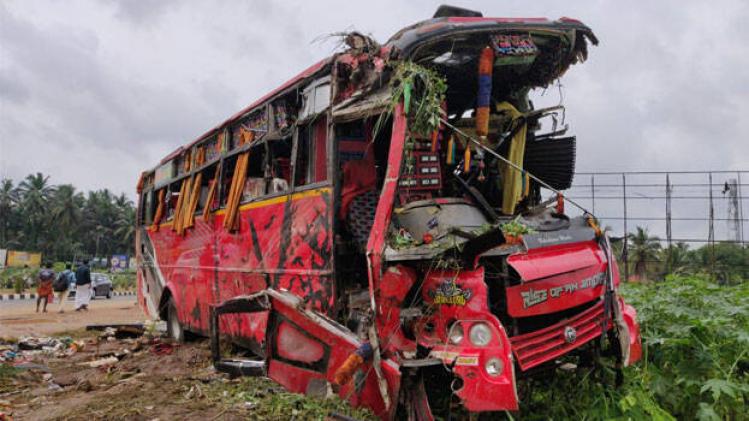
Kerala bus accident exposes fault lines in road rules

The tragic death of nine people, including five children, in a bus accident in Kerala two days ago has put the spotlight on the numerous road safety violations in the state and the ineffectiveness of penalties and other punitive actions by the authorities.
The nine deaths were a result of a private tourist bus ramming a KSRTC bus at high speed in Vadakkenchery in Kerala’s Palakkad district late on Wednesday (October 5).
As per the latest news reports, Jomon, the driver of the tourist bus, named Asura, has been arrested after a hunt by the police. He is said to have claimed that the driver of the KSRTC bus had applied sudden brakes.
As per preliminary investigation, the speed of the tourist bus was found to have been 97.72 kph as per its GPS data. A little before the accident, the bus had sent an alarm through the speed camera to the local RTO and the owner of the bus.
It was later disclosed that the bus was one among the 1,768 private buses to have been blacklisted by the state transport department for over-speeding. It was also found that there are five cases against the bus, registered with the regional transport office, Kottayam.
Private buses violate more
A cursory glance through the State Crime Records Bureau (SCRB) shows that the fatal accident that claimed nine lives is only one among the hundreds caused by private buses in the state. In 2021, private buses caused 919 accidents, of which, 108 were fatal, claiming the lives of 115 people.
KSRTC buses, on the other hand, were involved in around a third as many accidents as private buses — 329 accidents, with 60 fatal ones.
Also read: Haryana using live map technology to identify accident-prone areas
The trend is similar to previous years. In 2020, private buses caused 713 accidents, causing the death of 105 whereas KSRTC buses caused 296 accidents that claimed the lives of 52. These low numbers of 2020 are likely a result of the movement restrictions imposed in view of the Covid-19 pandemic.
In 2019, private buses caused 2,227 accidents, out of which 287 were fatal, causing the death of 303 people. KSRTC buses caused 862 accidents in the same year, causing the death of 194 persons.
Reasons for violations
The accident rate is generally very high in Kerala due to a number of reasons, such as the high density of vehicles and narrow roads with lots of twists and turns. However, private buses in Kerala are notorious for overspeeding, which is a result of the competition with rival bus groups.
Private tourist buses violate other rules, including colour codes and fitting extra lights. Some buses are turned into a dance floor as per the demands of the customers.
“Bus owners who adhere to rules often fail to get trips. The customers ask for ‘DJ lights and smoke’ when they book the bus for a tour. The buses that follow the colour code and do not have extra lights fail to get customers,” a bus operator at Ernakulam explains.
Court makes observations
The High Court of Kerala suo moto took up the case relating to the Vadakkenchery accident and sought an explanation from the transport commissioner on actions taken against violators.
“It is the element of recklessness that really should grip our attention now. As the Transport Commissioner has informed this court, even though large number of violations are being booked on a daily basis, it does not seem to create a tangible result on the ground because, presumably, even the offenders continue to do so being aware or being under the perception, that the consequences are trifle,” states the interim order issued by the single bench on Friday (October 7).
Also read: Mistry accident: Road safety audit flags poor maintenance, inadequate signages
In fact, a bus owner has to pay only ₹1,500 for a speeding ticket and ₹5,000 for violating the colour code and fitting extra lights. Often bus operators pay the fine whenever they are caught but are seen to repeat the offences.
The transport commissioner informed the High Court that the department has been monitoring the violations and taking action. According to the transport commissioner, the fatalities from accidents have come down to 13.7%.
However, the public perception is that action on traffic violations happens only when there is a fatal accident. The hue and cry fade away after a few days.
The High Court also expressed the same view; “It is common knowledge that initiatives and proposals are never new and every time an incident happens, such aspects are brought to life with vigour; however, only to be forgotten when a more engaging event happens,” stated the order.
“However, the children who lost their lives in this accident should never be forgotten.”
The court observed that the road culture has to be changed, which may have to be done through a clarion call to be made by the authorities who are vested with the powers under the statutory scheme.

